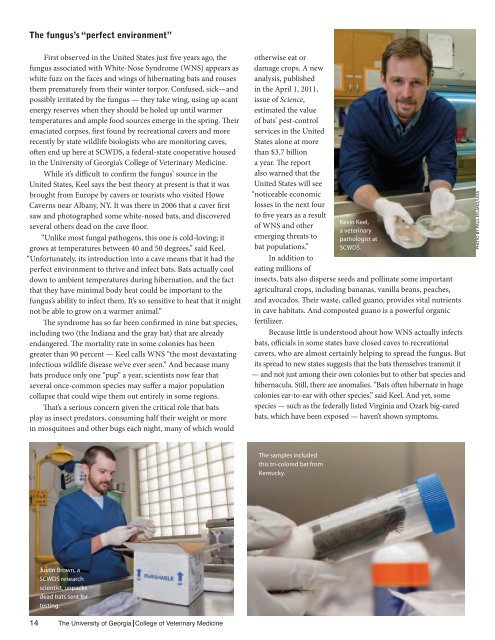Winter/Spring 2012 Aesculapian Magazine - University of Georgia ...
Winter/Spring 2012 Aesculapian Magazine - University of Georgia ...
Winter/Spring 2012 Aesculapian Magazine - University of Georgia ...
Create successful ePaper yourself
Turn your PDF publications into a flip-book with our unique Google optimized e-Paper software.
The fungus’s “perfect environment”<br />
First observed in the United States just five years ago, the<br />
fungus associated with White-Nose Syndrome (WNS) appears as<br />
white fuzz on the faces and wings <strong>of</strong> hibernating bats and rouses<br />
them prematurely from their winter torpor. Confused, sick—and<br />
possibly irritated by the fungus — they take wing, using up scant<br />
energy reserves when they should be holed up until warmer<br />
temperatures and ample food sources emerge in the spring. Their<br />
emaciated corpses, first found by recreational cavers and more<br />
recently by state wildlife biologists who are monitoring caves,<br />
<strong>of</strong>ten end up here at SCWDS, a federal-state cooperative housed<br />
in the <strong>University</strong> <strong>of</strong> <strong>Georgia</strong>’s College <strong>of</strong> Veterinary Medicine.<br />
While it’s difficult to confirm the fungus’ source in the<br />
United States, Keel says the best theory at present is that it was<br />
brought from Europe by cavers or tourists who visited Howe<br />
Caverns near Albany, NY. It was there in 2006 that a caver first<br />
saw and photographed some white-nosed bats, and discovered<br />
several others dead on the cave floor.<br />
“Unlike most fungal pathogens, this one is cold-loving; it<br />
grows at temperatures between 40 and 50 degrees,” said Keel.<br />
“Unfortunately, its introduction into a cave means that it had the<br />
perfect environment to thrive and infect bats. Bats actually cool<br />
down to ambient temperatures during hibernation, and the fact<br />
that they have minimal body heat could be important to the<br />
fungus’s ability to infect them. It’s so sensitive to heat that it might<br />
not be able to grow on a warmer animal.”<br />
The syndrome has so far been confirmed in nine bat species,<br />
including two (the Indiana and the gray bat) that are already<br />
endangered. The mortality rate in some colonies has been<br />
greater than 90 percent — Keel calls WNS “the most devastating<br />
infectious wildlife disease we’ve ever seen.” And because many<br />
bats produce only one “pup” a year, scientists now fear that<br />
several once-common species may suffer a major population<br />
collapse that could wipe them out entirely in some regions.<br />
That’s a serious concern given the critical role that bats<br />
play as insect predators, consuming half their weight or more<br />
in mosquitoes and other bugs each night, many <strong>of</strong> which would<br />
otherwise eat or<br />
damage crops. A new<br />
analysis, published<br />
in the April 1, 2011,<br />
issue <strong>of</strong> Science,<br />
estimated the value<br />
<strong>of</strong> bats’ pest-control<br />
services in the United<br />
States alone at more<br />
than $3.7 billion<br />
a year. The report<br />
also warned that the<br />
United States will see<br />
“noticeable economic<br />
losses in the next four<br />
to five years as a result<br />
<strong>of</strong> WNS and other<br />
emerging threats to<br />
bat populations.”<br />
In addition to<br />
eating millions <strong>of</strong><br />
Kevin Keel,<br />
a veterinary<br />
pathologist at<br />
SCWDS.<br />
insects, bats also disperse seeds and pollinate some important<br />
agricultural crops, including bananas, vanilla beans, peaches,<br />
and avocados. Their waste, called guano, provides vital nutrients<br />
in cave habitats. And composted guano is a powerful organic<br />
fertilizer.<br />
Because little is understood about how WNS actually infects<br />
bats, <strong>of</strong>ficials in some states have closed caves to recreational<br />
cavers, who are almost certainly helping to spread the fungus. But<br />
its spread to new states suggests that the bats themselves transmit it<br />
— and not just among their own colonies but to other bat species and<br />
hibernacula. Still, there are anomalies. “Bats <strong>of</strong>ten hibernate in huge<br />
colonies ear-to-ear with other species,” said Keel. And yet, some<br />
species — such as the federally listed Virginia and Ozark big-eared<br />
bats, which have been exposed — haven’t shown symptoms.<br />
Photo By PAUL EFLAND/UGA<br />
The samples included<br />
this tri-colored bat from<br />
Kentucky.<br />
Justin Brown, a<br />
SCWDS research<br />
scientist, unpacks<br />
dead bats sent for<br />
testing.<br />
14<br />
The <strong>University</strong> <strong>of</strong> <strong>Georgia</strong> College <strong>of</strong> Veterinary Medicine

















